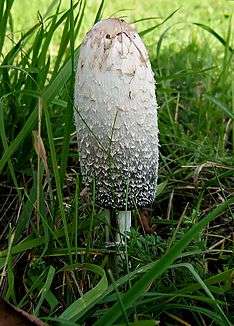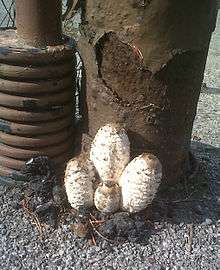Coprinus comatus
| Coprinus comatus | |
|---|---|
 | |
| the 'Inky' phase | |
| Scientific classification | |
| Kingdom: | Fungi |
| Division: | Basidiomycota |
| Class: | Agaricomycetes |
| Order: | Agaricales |
| Family: | Agaricaceae |
| Genus: | Coprinus |
| Species: | C. comatus |
| Binomial name | |
| Coprinus comatus (O.F.Müll.) Pers. (1797) | |
| Synonyms[1] | |
| Coprinus comatus | |
|---|---|
|
| |
| gills on hymenium | |
| cap is conical | |
| hymenium is free | |
| stipe has a ring | |
| spore print is black | |
| ecology is saprotrophic | |
| edibility: choice | |
Coprinus comatus, the shaggy ink cap, lawyer's wig, or shaggy mane, is a common fungus often seen growing on lawns, along gravel roads and waste areas. The young fruit bodies first appear as white cylinders emerging from the ground, then the bell-shaped caps open out. The caps are white, and covered with scales—this is the origin of the common names of the fungus. The gills beneath the cap are white, then pink, then turn black and secrete a black liquid filled with spores (hence the “ink cap” name). This mushroom is unusual because it will turn black and dissolve itself in a matter of hours after being picked or depositing spores.
When young it is an excellent edible mushroom provided that it is eaten soon after being collected (it keeps very badly because of the autodigestion of its gills and cap). If long-term storage is desired, microwaving, sauteing or simmering until limp will allow the mushrooms to be stored in a refrigerator for several days or frozen. Also, placing the mushrooms in a glass of ice water will delay the decomposition for a day or two so that one has time to incorporate them into a meal. Processing or icing must be done whether for eating or storage within four to six hours of harvest to prevent undesirable changes to the mushroom. The species is cultivated in China as food. The mushroom can sometimes be confused with the magpie fungus which is poisonous.
Taxonomy
The shaggy ink cap was first described by Danish naturalist Otto Friedrich Müller in 1780 as Agaricus comatus, before being given its current binomial name in 1797 by Christiaan Hendrik Persoon. Its specific name derives from coma, or "hair", hence comatus, "hairy" or "shaggy".[2] Other common names include lawyer's wig,[2] and shaggy mane.
Coprinus comatus is the type species for the genus Coprinus. This genus was formerly considered to be a large one with well over 100 species. However, molecular analysis of DNA sequences showed that the former species belonged in two families, the Agaricaceae and the Psathyrellaceae.[3] Coprinus comatus is the best known of the true Coprinus.
Description
The shaggy ink cap is easily recognizable from its almost cylindrical cap which initially covers most of its stem. The cap is mostly white with shaggy scales, which are more pale brown at the apex. The free gills change rapidly from white to pink, then to black. It is deliquescent. The stipe has a loose ring and measures 10–40 centimetres (3.9–15.7 in) high by 1–2.5 centimetres (0.39–0.98 in) diameter. Microscopically it lacks pleurocystidia. The spore print is black-brown and the spores measure 10–13 by 6.5–8 µm. The flesh is white and the taste mild.[4]
Distribution, habitat and ecology

It grows in groups in places which are often unexpected, such as green areas in towns. It occurs widely in grasslands and meadows in Europe and North America, from June through to November in the UK. It appears to have been introduced to Australia, New Zealand and Iceland. In Australia the species is sufficiently common to have been featured on a postage stamp issued by Australia Post in 1981.[5]
Coprinus comatus is a nematophagous fungus capable of killing and digesting the nematode species Panagrellus redivivus and Meloidogyne arenaria.[6][7]
Edibility
The young mushrooms, before the gills start to turn black, are edible. The taste is mild; cooking produces a large quantity of liquid. It can sometimes be used in mushroom soup with parasol mushroom. Large quantities of microwaved-then-frozen shaggy manes can be used as the liquid component of risotto, replacing the usual chicken stock.
Coprinus comatus is not to be confused with the common Ink Cap, which contains coprine and can induce coprine poisoning. Symptoms of coprine poisoning include vomiting, diarrhoea, palpitations and a metallic taste in the mouth. [8]
References
Much of the above article was translated from the French page and Dutch pages.
- ↑ "Coprinus comatus (O.F. Müll.) Pers. 1797". MycoBank. International Mycological Association. Retrieved 2012-03-03.
- 1 2 Nilson S & Persson O (1977). Fungi of Northern Europe 1: Larger Fungi (Excluding Gill-Fungi). Penguin. p. 72. ISBN 0-14-063005-8.
- ↑ Redhead, Scott A.; Vilgalys, Rytas; Moncalvo, Jean-Marc; Johnson, Jacqui; Hopple Jr., John S (February 2001). "Coprinus Pers. and the disposition of Coprinus species sensu lato". Taxon. 50 (1): 203–41. doi:10.2307/1224525. JSTOR 1224525.
- ↑ Phillips, Roger (2006). Mushrooms. Pan MacMillan. p. 257. ISBN 0-330-44237-6.
- ↑ AustralianStamp.com Coprinus comatus image
- ↑ Luo, Hong; Mo, Minghe; Huang, Xiaowei; Li, Xuan; Zhang, Keqin (Nov–Dec 2004). "Coprinus comatus: A basidiomycete fungus forms novel spiny structures and infects nematode". Mycologia. 96 (6): 1218–1224. doi:10.2307/3762137.

- ↑ Luo, H.; Liu, Y.; Fang, L.; Li, X.; Tang, N.; Zhang, K. (2007). "Coprinus comatus Damages Nematode Cuticles Mechanically with Spiny Balls and Produces Potent Toxins to Immobilize Nematodes". Applied and Environmental Microbiology. 73 (12): 3916–23. doi:10.1128/AEM.02770-06. PMC 1932715
 . PMID 17449690.
. PMID 17449690. 
- ↑ Collins, How to Identify Edible Mushrooms by Harding, Lyon & Tomblin
- Pierre Montarnal: Le petit guide: Champignons (Genève, 1964; Paris-Hachette, 1969).
- Régis Courtecuisse, Bernard Duhem: Guide des champignons de France et d'Europe (Delachaux & Niestlé, 1994–2000). ISBN 978-2-603-00953-6
- Roger Phillips: Mushrooms and other fungi of Great Britain and Europe (Pan Books Ltd. 1981 / Book Club Associates 1981) - for the English names.
External links
| Wikimedia Commons has media related to Coprinus comatus. |
| Wikispecies has information related to: Coprinus comatus |
- Coprinus comatus in Index Fungorum
- Fungus of the Month for May 2004: Coprinus comatus, the shaggy mane by Tom Volk, TomVolkFungi.net.
- "Coprinus comatus: The Shaggy Mane" by Michael Kuo, MushroomExpert.com, September, 2001.
- "California Fungi: Coprinus comatus", MykoWeb.com.
- "Wild About Mushrooms: Shaggy Mane Mushroom" by Louise Freedman, MykoWeb.com.
- Time-lapse photography of inky cap growing and liquefying on YouTube